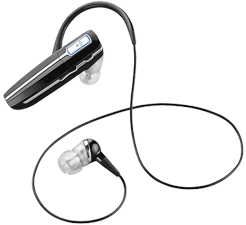 When the Jabra BT8010 arrived early this year at CES, we declared it one of the more innovative products we've seen thanks to its dual function as both a mono and a stereo Bluetooth headset--just add a secondary earpiece to convert from mono to stereo. While we loved the idea, we were rather disappointed with how big and heavy the earpieces were. Fast-forward several months later, and Plantronics has hopped on to a similar idea with a much improved design. Dubbed the Voyager 855, it also consists of a headset with a detachable stereo cable, but it's significantly more lightweight, more comfortable, and has better sound quality. Not only that, but it also has a sliding boom mic for better audio clarity. For those who want a stereo Bluetooth headset that can be used as a simple mono one as well, the Voyager 855 fits the bill and more. It will cost you though--the Voyager 855 is currently retailing for $149.95, but you can shop around for a better deal.
When the Jabra BT8010 arrived early this year at CES, we declared it one of the more innovative products we've seen thanks to its dual function as both a mono and a stereo Bluetooth headset--just add a secondary earpiece to convert from mono to stereo. While we loved the idea, we were rather disappointed with how big and heavy the earpieces were. Fast-forward several months later, and Plantronics has hopped on to a similar idea with a much improved design. Dubbed the Voyager 855, it also consists of a headset with a detachable stereo cable, but it's significantly more lightweight, more comfortable, and has better sound quality. Not only that, but it also has a sliding boom mic for better audio clarity. For those who want a stereo Bluetooth headset that can be used as a simple mono one as well, the Voyager 855 fits the bill and more. It will cost you though--the Voyager 855 is currently retailing for $149.95, but you can shop around for a better deal.Design of the Plantronics Voyager 855 Bluetooth headset
The Plantronics Voyager 855 consists of two pieces: the mono headset unit, which houses all the controls, and the detachable earpiece cable, which converts the 855 into a stereo headset. On its own, the mono headset unit looks like a regular Bluetooth headset. It looks very sleek and stylish, and we liked its black coat with silver trimming color scheme. Weighing in at a very lightweight 0.53 ounce, Plantronics claims that it is the smallest and lightest stereo Bluetooth headset to-date. Measuring 2.25 inches by 0.5 inch by 0.6 inch, the Voyager 855 is also on the slim side, though the length does increase to about 3 inches when the boom mic is slid out. The boom mic is actually the bottom three-quarters of the headset's front face, which can be slid down via two tiny plastic grips on the sides of the boom, or by simply pushing it downwards. The sliding mechanism is very smooth, though we felt that the act of sliding the boom down has the danger of dislodging the headset from the ear. Sliding the boom mic out provides better audio clarity (as it places the mic closer to the mouth), and you can also slide it out to answer calls. Sliding it back in will end the call.
Above the sliding boom is the multifunction button, while the right spine is home to the mute and volume keys. When in stereo mode, the mute key doubles as play/pause, while the volume keys doubles as track forward/back. We found these side keys to be extremely small, requiring us to use our fingernails to press them properly. Behind the headset is the earpiece, plus a slot for an optional ear loop for additional stability. The slot is also used to attach the stereo cable to the secondary earpiece. Both earpieces have silicone form-fitting earbud covers, and Plantronics had the foresight to include a variety of earbud cover sizes to accommodate different size ears. We found the fit to be extremely comfortable and snug and wore it for hours without noticeable discomfort. However, as we mentioned, the act of sliding the boom mic down sometimes resulted in the earpiece feeling a bit loose.
The secondary earpiece looks just like a regular earbud attached to an ear loop via an 18-inch cable. The ear loop is then attached to the headset unit via the aforementioned slot. It can be configured to be placed in either the left or right ear. The entire stereo setup is worn with the cable draped behind the neck.
Features of the Plantronics Voyager 855 Bluetooth headset
Features of the Voyager 855 are pretty basic. There's the typical answering, ending, and rejecting calls, as well as call mute, voice-dial support, and last-number redial. Because the Voyager 855 supports the AVRCP profile, you can also control your music via the headset's controls. Other features include a battery-life indicator and the ability to transfer calls from headset to the phone and vice versa.
Performance of the Plantronics Voyager 855 Bluetooth headset
We tested the Voyager 855 with the LG Trax. Pairing went very smoothly without any hiccups. Audio quality was simply stunning, thanks to Plantronics' Audio IQ technology. Callers could hear us without any problem and vice versa. However, there was still some amount of static and background noise in crowded situations, but that's nothing to worry about. What we also liked was that the headset alerted us to incoming calls during music playback, and we could switch out to the conversation and switch back to right where the music left off.
The Plantronics Voyager 855 has a rated talk time of 7 hours, a listening time of up to 6, and a rated standby time of 6.7 days.

0 comments: